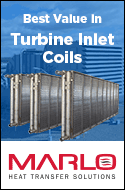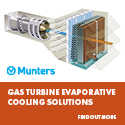FAQS
Chiller Systems
Q1: Can I add inlet chilling to any gas turbine?
A1: Yes. However, its economics will depend on various factors, including plant location, annual operating hours and the value of electric energy produced.
Q2: What is the difference between mechanical chilling and evaporative cooling?
A2: There are many differences, however, the major difference is that mechanical chilling can provide the GT with a constant inlet air temperature, which will result in a constant and predictable output. Evaporative cooling is a function of the ambient wet bulb temperature and, consequently, the inlet air temperature will fluctuate.
Q3: How much power augmentation can I expect by installing an inlet chilling system?
A3: Depending on the ambient design point, a gross power augmentation can be up to 30%.
Q4: Should glycol be added to the inlet chilling system?
A4: In order to prevent freezing during cold weather, glycol should be added unless one plans to drain water during cold weather
Q5: What additional pressure drop can I expect in the inlet filter house if I add inlet chilling?
A5: Pressure drop across an inlet chilling coil is typically <1"WC
Q6: How do I determine the design point for my inlet chilling system?
A6: The design point can be selected using the ASHRAE weather data for a city closest the site. However, the most accurate way is to select the design point is using hourly weather data, and cost and benefit analyses.
Q7: What GT downtime is required to install inlet chilling?
A7: Inlet air chilling systems are typically installed during major scheduled outages. Filter house modifications can be completed in as little as one to two weeks.
Q8: How much maintenance is required on an inlet chilling system?
A8: Maintenance requirement is minimal. The chillers are the largest pieces of equipment to be maintained-this is typically carried out by the chiller OEM on an annual basis. The chiller maintenance is relatively inexpensive with little downtime.
Q9: Will the inlet chilling system affect the maintenance of the gas turbine?
A9: A properly designed chilling system does not affect the maintenance of the gas turbine.
Q10: Can I make provisions in a new GT system for inlet chilling in the future?
A10: Yes. There are four main considerations: additional capacity in auxiliary transformers, chilled water supply and return pipe routes, coil-ready filter house designs, and the footprint of the inlet chilling system.
Q11: Can chilling system suppliers perform “turnkey” project delivery?
A11: Yes. Many chiller system vendors can provide seamless turnkey projects.
Q12: Can chilling systems come with performance guaranty?
A12: Yes. However, guarantees may vary by the customer preference. Guarantee may include, chilled water temperature and flow rate and pressure drop across the inlet filter house. If the total system is being supplied by one vendor, gas turbine performance may also be guaranteed.




